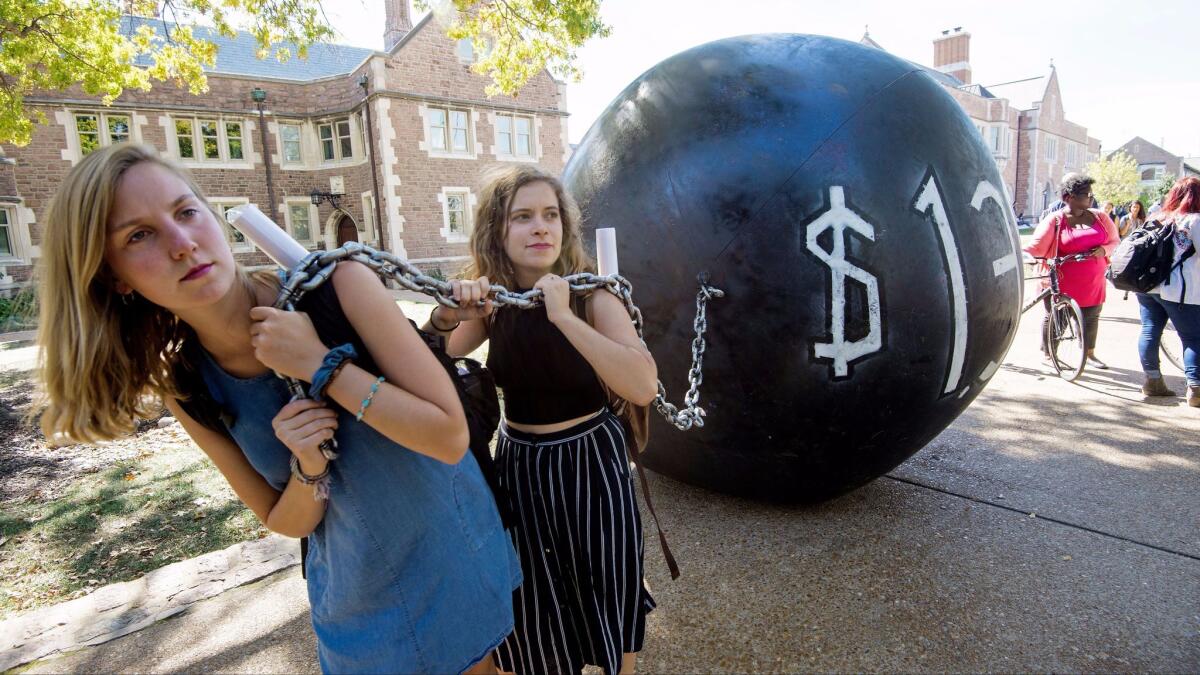Debate on college affordability spurs California lawmakers to offer proposals to help students

Reporting from Sacramento â Itâs a time of looming tuition bumps, soaring student debt and a national debate on âfree collegeâ thatâs lingered beyond the 2016 presidential race â and lawmakers in Sacramento have taken notice.
California legislators have introduced at least three dozen bills this year that aim to make college more affordable, including proposals to freeze tuition, demystify student loan statements and make textbooks cheaper.
The breadth of ideas points to an unusual degree of attention being paid in the Capitol to higher education costs.
âI donât think weâve ever seen more focus on college affordability than we do now,â said Debbie Cochrane, vice president of the Institute for College Access & Success, a nonprofit advocacy group.
The attention from lawmakers reflects a growing worry from their constituents over the price of a higher education.
A survey in December from the Public Policy Institute of California found that 57% of adults believed affordability was a big problem for the stateâs public colleges and universities. Nearly three-quarters of those polled said they believed the high costs were preventing qualified and motivated students from going to college.
Mark Baldassare, president of PPIC, said the sentiments could be seen as echoes of the 2016 presidential race, particularly the Democratic primary in which Bernie Sanders made calls for tuition-free public colleges and universities a centerpiece of his campaign.
âThis was a year in which people heard a lot of things about the need for college and the need for free community college,â Baldassare said.
The issue became even more visible as California institutions considered their first tuition hikes in six years. University of California regents approved a 2.5% tuition increase in January. California State University trustees are examining boosting tuition on their campuses by 5%.
In response, Assemblywoman Sharon Quirk-Silva (D-Fullerton) introduced AB 393, a measure that would freeze Cal State and community college tuition, and encourage UC campuses to do the same.
Other legislators want to increase state-funded aid such as Cal Grants, a three-tiered system that comprises a mix of entitlements for certain eligible students and competitive awards.
Californiaâs existing aid programs currently top $2 billion, according to the Legislative Analystâs Office. More than 60% of Cal State students have their full tuition covered, as do around half of UC and community college students.
Assemblyman Miguel Santiago (D-Los Angeles) wants to eliminate community college tuition in the first year for all full-time students. Santiago said his proposal, AB 19, was inspired by his own background as the child of immigrant parents whose time at Moorpark College enabled him to transfer to UCLA.
âThere are a lot of students with histories and backgrounds like mine,â Santiago said. âCommunity college is really that one opportunity theyâre going to have to make something out of their lives and share in the California dream.â
The affordability debate extends beyond the sticker price of tuition. The spate of proposals this year reflects a more holistic conversation about the numerous living expenses and equipment costs that are part of a college education.
âItâs almost taken as a given that the cost of college was about a lot more than tuition. I donât know if we wouldâve had the same discussion years ago in the same way,â said Jacob Jackson, a higher education research fellow at PPIC.
The broader focus âis a good thing,â Jackson added. âTuition is about 30 to 40% of attending public college in California.â
Prompted by a request last year by Assemblyman Kevin McCarty (D-Sacramento), the Legislative Analystâs Office examined what it would take to make Cal State and UC schools entirely âdebt-freeâ for students. Researchers estimated it would take $3.3 billion to ensure students would not have to take on debt for tuition or living expenses.
While no measures this year take such a sweeping step, several legislators seek to chip away at some of the costs associated with college. One measure, AB 960 by Assemblyman William P. Brough (R-Dana Point), would exempt higher education textbooks from sales tax. And Assemblyman David Chiu (D-San Francisco) plans to push for emergency financial assistance for students to offset unexpected housing and other living costs.
Other lawmakers hope to assist those already burdened with debt. With SB 674, state Sen. Ben Allen (D-Santa Monica) wants to create a public program for refinancing high-interest private student loans. A measure by Assemblyman Ian Calderon (D-Whittier), AB 1178, would require colleges to send students personalized reports detailing their cumulative loan amounts and the percentage of federal borrowing limits they have reached.
Calderon, 31, said student loans â which have topped $1 trillion nationally â are the top policy concern for millennial lawmakers like himself.
âWeâre just watching a financial crisis getting ready to smack us in the face,â he said.
Creative policymaking aside, legislators acknowledge the college affordability dilemma largely boils down to money in the state budget.
âThereâs been a relentless disinvestment in higher education,â said Allen, who chairs the Senate Education Committee. âItâs a travesty.â
Gov. Jerry Brownâs initial budget plan unveiled in January modestly boosts overall higher education spending. But it would phase out a scholarship geared toward middle-class families, arguing that aid should be directed toward Californiaâs neediest students. The spending plan also would decrease Cal Grants for private institutions by 11%.
With the stateâs fiscal outlook potentially strained, advocates say lawmakers will have to wrestle with what kind of aid programs should be prioritized â a debate that is significantly more nuanced than the rallying cry of âfree college.â
âThe things that are going to help students most are not the things that are easiest to grasp. A good policy is often thorny,â Cochrane said.
âAttention on the problem is a really good thing,â she added. âBut itâs incumbent upon all of us to work toward what are the real solutions and not just the soundbites.â
Follow @melmason on Twitter for the latest on California politics.
Hereâs what would it take to give California students a debt-free college education
UC regents approve first tuition increase after six-year freeze; some students âinfuriatedâ
More to Read
Get the L.A. Times Politics newsletter
Deeply reported insights into legislation, politics and policy from Sacramento, Washington and beyond. In your inbox three times per week.
You may occasionally receive promotional content from the Los Angeles Times.











